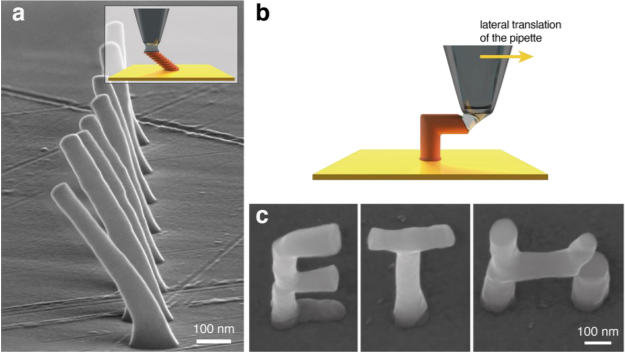A team of researchers from Switzerland and Singapore has set a new benchmark in electrochemical 3D printing. They’ve combined techniques from additive manufacturing and electrodeposition to form 25 nm diameter-sized copper voxels. This “3D printing” process is adjustable, allowing the formation of complex shapes and structures.
 Image Credit: Hengsteler, J., et al., (2021) Bringing Electrochemical Three-Dimensional Printing to the Nanoscale. Nano Letters, [online] 21(21), pp.9093-9101. Available at: https://pubs.acs.org/doi/10.1021/acs.nanolett.1c02847
Image Credit: Hengsteler, J., et al., (2021) Bringing Electrochemical Three-Dimensional Printing to the Nanoscale. Nano Letters, [online] 21(21), pp.9093-9101. Available at: https://pubs.acs.org/doi/10.1021/acs.nanolett.1c02847
Nanoengineering applications require the modeling of complex structures at nanometer scales. While electrochemical techniques yield materials with superior electrical conductivity, applications below 100 nm resolutions remain unattainable.
The team’s novel application of 3D printing with electrodeposition opens up opportunities in electronics, nano-optics, nanorobotics and energy storage nanodevices.
Moving Beyond 3D Printing
Advanced optical, sensing and energy storage devices require the structuring of functional elements at nanometer scales.
In additive manufacturing, also known as 3D printing, shapes are formed by depositing layers of material onto each other, which subsequently bind to form the desired shape. Since these layers are deposited through a nozzle, itself controlled by computer-aided manufacturing (CAM) software, complex shapes can be formed.
However, conventional 3D printing techniques - which include stereolithography and focused beam techniques - only yield materials with limited properties.
In electroplating, electrodeposition is used to coat an object in a layer of conductive metal. Thus, materials such as plastics can be imbued with metals’ strength, conductivity and corrosion resistance while retaining their native characteristics.
The multidisciplinary team was not so much interested in coating a material but rather in exploiting the electrolysis process. In this process, materials are transferred between two electrodes when a direct current is applied to an electrolyte solution.
The team used nanopipettes (nozzles) with diameters as small as 1.6 nm to place positively charged copper ions onto a negatively charged substrate (glass or silicon). The nanopipette and substrate surface acted as the electrodes.
It may seem straightforward to control the size of the printed structures by simply varying the size of the nozzle openings. The difficulty, however, lies in synchronizing the movement of the nozzles with the growth of the structures without clogging the nozzles. Thus, previous attempts to “print” at resolutions below 100 nm have been unsuccessful, with the smallest resolution of 250 nm achieved for printing copper structures (essential in nanoelectronics).
The team limited the electroplating process to the liquid meniscus formed in air between the nozzle tip and substrate. Thus, they were able to precisely control the printing process based on the rapid forming and breaking of the meniscus. They could tune the features of copper voxels on the fly down to resolutions of about 25 nm.
Tunable 3D Nanoprinting
The team from ETH Zurich and Nanyang Technological University in Singapore used quartz nanopipettes with opening diameters of 1.6, 2, 45 and 253 nm as print nozzles. The nozzles were filled with an electrolyte solution containing metal Cu2+ ions. Precise positioning of the nozzles was achieved by micromotors for coarse movement control and piezo actuators for nano-level control.
As the tip of the nanopipettes were brought close enough to the substrate surface, a meniscus formed, and electrodeposition began.
The magnitude of the current was dedicated by a predefined voltage threshold which, once reached, caused the nozzles to retract. Once this happened, the meniscus broke, and the current stopped flowing. The meniscus itself only existed for a few milliseconds (∼1,000 times faster than in other approaches). The process repeated until the desired printed height was reached.
Using this approach, the team was able to recreate complex structures at less than 100 nm resolutions. In one example, 656 copper voxels were printed, each 240 nm in height. Other geometries, such as intricate curved helix-like structures, were also printed. The researchers were able to control the sizes and thicknesses of these structures by varying the voltage of the current applied. Thus, they could control voxel sizes on the fly without the need to alter nozzle diameters.
This novel approach opens up new possibilities for electronics, nano-optics, nanorobotics and energy storage nanodevices.
References and Further Reading
Hengsteler, J., et al., (2021) Bringing Electrochemical Three-Dimensional Printing to the Nanoscale. Nano Letters, [online] 21(21), pp.9093-9101. Available at: https://pubs.acs.org/doi/10.1021/acs.nanolett.1c02847
Formlabs. (2021) Electroplating 101: How Metal Plating Works. [online] Available at: https://formlabs.com/uk/blog/electroplating-metal-plating/
Disclaimer: The views expressed here are those of the author expressed in their private capacity and do not necessarily represent the views of AZoM.com Limited T/A AZoNetwork the owner and operator of this website. This disclaimer forms part of the Terms and conditions of use of this website.